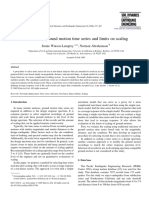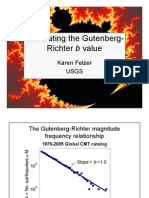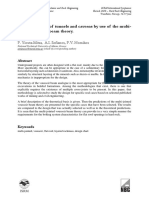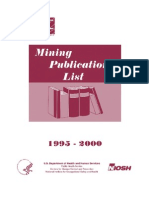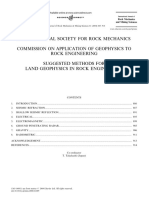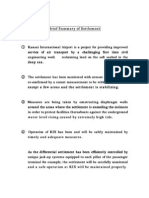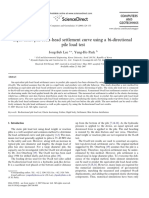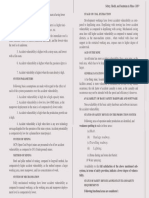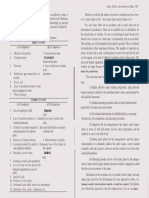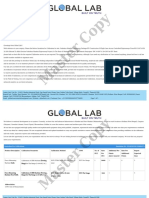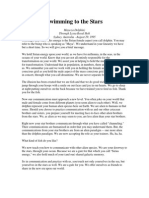Max Charge Per Delay
Max Charge Per Delay
Uploaded by
Vidya SagarCopyright:
Available Formats
Max Charge Per Delay
Max Charge Per Delay
Uploaded by
Vidya SagarOriginal Description:
Copyright
Available Formats
Share this document
Did you find this document useful?
Is this content inappropriate?
Copyright:
Available Formats
Max Charge Per Delay
Max Charge Per Delay
Uploaded by
Vidya SagarCopyright:
Available Formats
Advances in Neural Networks, Fuzzy Systems and Artificial Intelligence
Assessment of Maximum Explosive Charge Used Per Delay in Surface
Mines
MANOJ KHANDELWAL1 & NIKOS MASTORAKIS2
1
Department of Mining Engineering,
College of Technology and Engineering,
Maharana Pratap University of Agriculture and Technology, Udaipur – 313 001,
INDIA
mkhandelwal1@gmail.com http://ctae.ac.in/index.php?id=57&type=DP
2
Technical University of Sofia,
Department of Industrial Engineering, Sofia
BULGARIA
mastor@wseas.org http://elfe.tu-sofia.bg/mastorakis
Abstract: - The present paper mainly with deals the prediction of safe charge of explosive used per delay (Qmax)
using artificial neural network (ANN) incorporating peak particle velocity (PPV) and distance between blast
face to monitoring point (D). 120 blast vibration data sets were monitored at different vulnerable and strategic
locations in and around a major coal producing opencast coal mines in India. 100 blast vibrations records were
used for the training of the ANN model vis-à-vis to determine site constants of various conventional vibration
predictors. Rest 20 new randomly selected data sets were used to compare the ANN prediction results with
widely used conventional predictors. Results were compared based on coefficient of determination (R2)
between measured and predicted values of Qmax. It was found that coefficient of determination between
measured and predicted Qmax by ANN was 0.894, whereas it was ranging from 0.023 to 0.417 by different
conventional predictor equations.
Key-Words: - Safe explosive charge used per delay; peak particle velocity; distance between blast face to
monitoring point; conventional vibration predictors; artificial neural network
1 Introduction
The exploitation of economic minerals from earth As the ground vibration is the most important
crust is increasing day by day at a faster pace since environmental effect of blasting operation some
last decade to fulfill the increasing demand of regulations related to structural damages caused by
minerals. This has led to the substantial increase in ground vibration have been developed [6]. The
the consumption of explosive. When an explosive regulations are primarily based on the peak particle
detonates in a blast hole, a tremendous amount of velocity (PPV) resulted from blasting operations.
energy, in terms of pressure (up to 50 GPa) and To come out with proper amounts of Maximum
temperature (up to 5000 K), is released [1-3]. Charge per Delay which produces limited ground
Although, significant developments have taken vibration, several empirical conventional vibration
place in explosive technology, the explosive energy predictors are available proposed by different
utilization has not made much progress due to the researchers [7-10]. These conventional predictors
complexity of the various rock parameters. Only a are normally used for estimating PPV of ground
fraction of explosive energy (20-30%) is used in vibration by blasting. All the predictors estimate
the actual breakage and displacement of the rock the PPV mainly based on two parameters
mass, and the rest of the energy is spent in (maximum charge used per delay and distance
undesirable effects like ground vibrations, fly between blast face and monitoring point). For the
rocks, noises, back breaks, over breaks, etc. [4-5]. same excavation site, different predictors give
different values of safe PPV vis-à-vis safe charge
per delay. There is no uniformity in the predicted
ISBN: 978-960-474-379-7 100
Advances in Neural Networks, Fuzzy Systems and Artificial Intelligence
result by different predictors [11-12]. It seems that [14]. Moreover, it has been proven that a feed-
there is a great need to evaluate the efficiency and forward ANN with an arbitrary number of
credibility of various empirical conventional processing units is a universal function
predictors to calculate maximum charge per delay. approximator [15].
Progress has been made in recent years in ability to 3.1 Feed Forward Back Propagation Neural
predict the Qmax, but the state of the art is deficient Network
in many ways. On the basis of detailed Feed forward neural networks are being widely
investigation, a viable approach for the prediction used for solving various ticklish problems, such as
is necessary, and an Artificial Intelligence (AI) pattern recognition, function approximation,
comes in handy to fulfill this approach. In the dynamic modeling, data mining, time series
present paper, an attempt has been made to predict forecasting, etc. Feed forward networks have one or
the safe charge of explosive per delay using more hidden layers of sigmoid neurons followed by
artificial neural network (ANN) by incorporating an output layer of linear neurons. Multiple layers of
peak particle velocity (PPV) and distance from neurons with nonlinear transfer functions allow the
blast face to monitoring point (D). Prediction network to learn nonlinear and linear relationships
capability of ANN is also compared by various between the input and the output vectors [16]. In
available conventional predictors based on light of Kolmogorov’s theorem, multilayer feed
coefficient of determination. forward network can be viewed as exact
representation of input-output mapping. Further
modification over Kolmogorov’s theorem is made
2 Site description by [17] to obtain the exact representation equation.
The study was conducted at Jayant opencast mine To overcome the difficulty of exact mapping,
of Northern Coalfields Limited (NCL), which is a approximate representation is obtained. Multilayer
subsidiary company of Coal India Limited. It is feed forward found its mathematical form here. A
located at Singrauli, Distt. Sidhi (M.P.), India. The multilayer feed forward network when learns by
area of NCL lies geographically between latitudes back propagation, in which error propagates back is
of 24o 0’ to 24o 12’ and longitudes 82o 30’ to 82o called feed forward back propagation (FFBP).
45’ and belongs to Gondwana super group. The dip Kolmogorov’s theorem however, fails to provide
of the strata is gentle and varying from 20 to 50. The not only number of layers but also number of
coalfield can be divided into two sub basins, viz. neurons necessary in each hidden layer.
Moher sub-basin (312 sq. km.) and Singrauli Main
basin (1890 sq. km.). The field is divided into 11
major mining blocks namely Kakri, Bina, Marrack, 3.2 Learning of Feed Forward Back
Khadia, Dhudhichua, Jayant, Nighahi, Amlohri, Propagation Network
Moher, Gorbi and Jhingurdah. The overburden in Training of the network is basically a process of
this area is mostly medium to coarse-grained arriving at an optimum weight space of the
sandstones, carbonaceous shales and shaly network. The descent down the error surface is
sandstones. Nonel and MS connectors are used for made using the following rule:
initiation. The inter-hole delay was 17-25 ms,
whereas, inter-row delay was 2-4 times the inter- ∂E
hole delay. ∆wη = η ( )
∂wη
Where,
3 The Philosophy of Artificial Neural η is the learning rate parameter.
wη is the weight of the connection between
Network the ith neuron of the input layer and the jth
The technique of artificial neural networks (ANNs)
neuron of the hidden layer.
is an effective alternative methodology. The
artificial intelligence information-processing The update of weight for the (n+1)th pattern is given
structures are still very primitive compared to
as:
biological ones [13]. There is a wide scope to solve
wη (n+1) = wη (a) + ∆ wη (n)
problems by the ANNs particularly to approximate
nonlinear behavior without a prior knowledge of
Similar logic applies to the connection between the
interrelations among the elements within a system
hidden and the output layer.
ISBN: 978-960-474-379-7 101
Advances in Neural Networks, Fuzzy Systems and Artificial Intelligence
The error E is the mean squared error and is maintain statistical consistency. Datasets for
determined by the following relation: validation were extracted at regular intervals from
E = Σ [Ok (n) – Ok’ (n)]2 the sorted database and the remaining datasets were
(3) used for the training and testing of ANN model vis-
à-vis to determine site constant of various
Where, conventional vibration predictors. The range of
Ok (n) is the output determined by the distance of monitoring point from blasting face and
network for the nth pattern and Ok’ (n) is the PPV is 35 – 640 m and 1.97 – 82.0 mm/s
corresponding output given in the training respectively, whereas range of explosive charge
data set. used per delay (Qmax) is 25 – 606.25 kg.
The weight change rule is a development of the
perception learning rule. Weights are changed by 5 Network Architecture
an amount proportional to the error at that unit Feed forward back propagation neural network
times, the output of the unit feeding into the weight. architecture (2-6-1) is adopted due to its
appropriateness for the identification problem.
The output unit error is used to alter weights on the Pattern matching is basically an input/output
output units. Then, the error at the hidden nodes is mapping problem. The closer the mapping, better
calculated (by back – propagating the error at the the performance of the network is.
output units through the weights), and the weights
on the hidden nodes altered using these values. A three layer feed-forward back-propagation neural
network was developed to predict the Qmax. The
For each data pair to be learned a forward pass and input layer has 2 input neurons and the output layer
backward pass is performed. This is repeated over has 1 neuron, whilst the hidden layer comprises 6
once again until the error is at a low enough (or is hidden neurons (Fig. 1).
given up). The input and the hidden layers consists
of linear processing units as neurons, whereas, the All the input and output parameters were scaled
output layer consists of non-linear processing units between 0 and 1. Equation 5 was used for the
as the neurons. The non-linear function used is the scaling of input and output parameters.
logarithmic sigmoid function and is defined as: Scaled value = (max. value – unnormalised value) /
1 (max. value – min. value) (5)
f (net ) =
(1 + e − net )
(4)
Where,
f (net) is the weighted sum of the inputs for
a processing unit.
Thus, the outputs are determined for each epoch, PPV
the mean square error calculated and the weights
updated till a user specified error goal or epoch QMAX
goal is reached successfully.
Distance
4 Data Set
One of the most important stages in the ANN
technique is data collection. In the present study,
120 blast vibration records were monitored at
different vulnerable and strategic locations in and Fig. 1 Suggested ANN for the case study
around the mines as per ISRM [18] standards.
Among which, 100 blast vibration data sets were
chosen for the training of the network and rest 20
6 Testing and Validation of ANN
data sets were used for the testing of the ANN Model
network. The data was divided into training and To test and validate the ANN model, a data sets
validation datasets using sorting method to were chosen, which was not used while training the
ISBN: 978-960-474-379-7 102
Advances in Neural Networks, Fuzzy Systems and Artificial Intelligence
network, was employed. The results are presented
in this section to demonstrate the performance of Where,
the networks. Coefficient of determination (R2) v = Peak particles velocity (PPV), mm/s,
between the predicted and measured values is taken Qmax = Maximum charge per delay, kg,
as the measure of performance. As Bayesian D = Distance between blast face to
interpolation [19] has been used, there was no vibration monitoring point, m, and
danger of over-fitting or under-fitting problems. K, B, and n = Site constants.
Fig. 2 illustrates the measured and predicted Qmax.
Fig. 2 clearly indicates the ability of ANN for the Empirical equations are versions of the following
prediction of Qmax. Here, coefficient of general form that typically are used by investigators
determination is as high as 0.894. [20]
PPV = K.Da.Qmaxb
Where, PPV is the peak particle velocity, Qmax is
Maximum charge per delay (kg), D is distance of
the measuring transducer form the blasting face
(m), and K, a and b are site-specific constants,
which can be determined by multiple regression
analysis.
All the conventional vibration predictors have site
specific constants. The value of site constants also
Fig 2 Measured vs. predicted Qmax by ANN varied as the ground conditions changed.
Moreover, these are derived based on only two
parameters, i.e. Maximum charge per delay and the
7 Estimation of Maximum Charge distance from monitoring point to blast face.
Per Delay by Conventional Predictors
Table 1 illustrates the various available These conventional vibration predictors (Table 1)
conventional vibration predictor equations have been advocated in order to analyse the blast
proposed by different researchers [7-10]. These data. The site constants of these predictors were
predictors have been employed to calculate the safe determined from the multiple regression analysis of
quantity of charge that can be blasted per delay, the 100 blast vibration cases. The calculated values
with minimum abuse in the surrounding rock mass. of site constants as well as their respective
coefficient of determination (R2) for the various
Table 1 Different conventional vibration predictors predictor equations are given in Table 2.
Name Equation Table 2 shows that the Ambraseys – Hendron and
USBM [7] v = K (D/√Qmax)-B CMRI predictor has quite remarkable coefficient of
v = K [D/ (Qmax) 1/3]- determination, whereas Bureau of Indian Standard
Ambraseys – Hendron [8] B predictor has very less coefficient of determination,
so it will not be able to predict the Qmax in a
Bureau of Indian Standard
v = K [(Qmax/D2/3]) B proficient manner. It should be noted here that the
[9]
resulted coefficient of determination is just for the
v=n+K
CMRI Predictor [10] equations in the form of offered one.
(D/√Qmax)-1
Table 2 Calculated values of site constants
Name of the Site Constants
Final Qmax Equation R2
Predictor K B n
USBM 114.025 0.923 Qmax = D2(v/114.025.34)2/0.923 0.468
Ambraseys – 0.555
399.945 1.079 Qmax = D3(v/399.945)3/1.079
Hendron
Bureau of Indian 6.397 0.334 Qmax = D2/3(v/6.3971/0.334 0.101
ISBN: 978-960-474-379-7 103
Advances in Neural Networks, Fuzzy Systems and Artificial Intelligence
Standard
CMRI Predictor 165.6 - 0.644 Qmax = D2(v+0.644/165.6)2 0.738
Figs. 3-6 demonstrates the prediction capability
of various conventional predictors to predict
Qmax. Here, coeffeicnt of determination is
ranging between 0.023 to 0.417, which is
highest for the Ambraseys – Hendron
predictor, whereas minimum for the Bureau of
Indian Standard predictor. Though, while
calculating site contants of various predicotrs
for 100 blast cases, CMRI predictor had shown
highest coefficient of determination, but for 20
randomly selected different blast cases, Fig 4 Measured vs. predicted Qmax by Ambraseys-
Ambraseys – Hendron predictor is showing Hendron predictor
highest coefficient of determination.
Table 2 shows that the Ambraseys – Hendron and
CMRI predictor has quite remarkable coefficient of
determination, whereas Bureau of Indian Standard
predictor has very less coefficient of determination,
so it will not be able to predict the Qmax in a
proficient manner. It should be noted here that the
resulted coefficient of determination is just for the
equations in the form of offered one.
Figs. 3-6 demonstrates the prediction capability of
Fig 5 Measured vs. predicted Qmax by Bureau of
various conventional predictors to predict Qmax.
Indian Standard predictor
Here, coeffeicnt of determination is ranging
between 0.023 to 0.417, which is highest for the
Ambraseys – Hendron predictor, whereas minimum
for the Bureau of Indian Standard predictor.
Though, while calculating site contants of various
predicotrs for 100 blast cases, CMRI predictor had
shown highest coefficient of determination, but for
20 randomly selected different blast cases,
Ambraseys – Hendron predictor is showing highest
coefficient of determination.
Fig 6 Measured vs. predicted Qmax by CMRI
predictor
8 Results and Discussion
In this section, a prediction performance
comparison is made between the presently
constructed ANN model and the conventional
predictor models. The results of applying the
Fig 3 Measured vs. predicted Qmax by USBM various conventional predictors and ANN are
predictor compared in Table 3. Table 3 shows the coefficient
of determination (R2) for all the 4 vibration
predictors as well as for ANN model also. As seen
ISBN: 978-960-474-379-7 104
Advances in Neural Networks, Fuzzy Systems and Artificial Intelligence
in this table, the applicability of ANN is far better underground blast. ISI Bulletin 1973; IS –
than any of the conventional predictor equations. 6922.
4. Cheng G, Huang SL. Analysis of ground
Table 3 Coefficient of determination of various vibration caused by open pit production blast.
models Explosive and Blasting Technique, Holmberg
Name of Model R2 (Ed.), Balkema; 2000, p. 63-70.
USBM 0.263 5. Davies B, Farmer IW, Attewell PB. Ground
Ambraseys – Hendron 0.417 vibrations from shallow sub-surface blasts. The
Bureau of Indian Standard 0.023 Engineer, London, 1964; 217, p. 553-559.
CMRI Predictor 0.327 6. Demuth H & Beale M. 1994, Neural network
ANN 0.894 toolbox for use with MATLAB, Mathworks
Inc, 158.
7. Dowding CH. Blast vibration monitoring and
control. Englewoods Cliffs: Prentice-Hall Inc;
9 Conclusions 1985, p. 288-290.
The main aim of this study is to predict maximum
8. Duvall, WI, Petkof B. Spherical propagation of
charge per delay which is one of the most important
explosion generated strain pulses in rock.
factors in blast pattern designing. The ANN model
USBM, RI 5483, 1959; p. 21.
predicts maximum charge per delay value as an
9. Fausett, L. Fundamentals of Neural Networks.
output parameter for a given PPV and distance
Architectures, Algorithms, and Applications.
from the blast face. The comparison shows that
Prentice-Hall,Upper Saddle River, New Jersey
results from ANN model are close to the real ones
462, 1994.
that are desirable. ANN results indicate very close
10. Hagan TN. Rock breakage by explosives, in:
agreement for the Qmax with the field data sets as
Proc. Nat. Symp. Rock Fragmentation,
compared to conventional predictors.
Adelaide, 1973. p. 1 – 17.
11. Haykin, S., Neural Networks: A
All the conventional predictors have site specific
Comprehensive Foundation. Prentice-Hall,
constants and these are not able to predict the safe
Upper Saddle River, New Jersey 842, 1999.
charge for even other similar geo-mining
12. Hino K. Fragmentation of rock through
conditions. The predictor equations proposed by
blasting. J Ind Explosive Soc 1956;17(1):1–11.
various researchers show good correlation in
13. Hornik, K. Some new results on neural network
calculation of PPV and a low correlation while
approximation. Neural Networks 1993:6,
calculating maximum safe charge per delay, as it
1069–1072.
calculates Qmax by back calculation. If the safe
14. ISRM. Suggested method for blast vibration
charge of explosive is calculated based on the
monitoring. Int J Rock Mech Min Sci and
above predictors, certainly one can face problems Geomech Abst 1992; 29:145-146.
to control the ground vibration. This may,
15. Khandelwal M, Singh TN. Prediction of Blast
sometimes, result in either under estimate or over Induced Ground Vibration using Artificial
estimate the explosive requirement. The uses of any Neural Network, Int J Rock Mech Min Sci
predictor without validation causes damage to the
2009,:46, 1214-1222.
surround and hinder the mine smooth working. 16. Khandelwal M, Singh TN. Evaluation of blast
induced ground vibration predictors. Soil
Dynam Earthq Engg 2007; 27:116-125.
References 17. Lorentz, G.G. Coalescence of matrices,
1. Alipour A., Ashtiani M. Fuzzy modeling
regularity and singularity of Birkhoff
approaches for the prediction of maximum interpolation problems. J. Approximation
charge per delay in surface mining, Int J Rock
Theory 1977:20 (2), 178--190.
Mech Min Sci 2011:48:305–310. 18. MacKay DJC. Bayesian interpolation, Neural
2. Ambraseys NR, Hendron AJ. Dynamic Computation 1992; 4:415 – 447.
behaviour of rock masses, Rock Mechanics in
19. McKenzie C. Quarry Blast monitoring
Engineering Practices, London: John Wiley and Technical and Environmental Perspective,
Sons; 1968, p. 203 – 207.
Quarry Management 1990; 23-29.
3. Bureau of Indian Standard. Criteria for safety 20. Pal Roy P. Putting ground vibration predictors
and design of structures subjected to
into practice, Colliery Guardian 1993; 241:63-
67.
ISBN: 978-960-474-379-7 105
You might also like
- Assignment A2.0 - Slope StabilityDocument3 pagesAssignment A2.0 - Slope Stability2685866No ratings yet
- Cost Models of Theoretical Mining Operations - CostMine PDFDocument5 pagesCost Models of Theoretical Mining Operations - CostMine PDFVidya Sagar50% (2)
- Selection of Ground Motion Time Series and Limits On ScalingDocument6 pagesSelection of Ground Motion Time Series and Limits On ScalingAbdelwahabNo ratings yet
- A Review of Recent Experience in Modeling of Caving - Mark BoardDocument11 pagesA Review of Recent Experience in Modeling of Caving - Mark BoardFajar SariandiNo ratings yet
- Part 2. Suggested Method For Determining Deformability of Rock Materials in Uniaxial CompressionDocument3 pagesPart 2. Suggested Method For Determining Deformability of Rock Materials in Uniaxial CompressionHatemNo ratings yet
- Surface Subsidence Engineering: Theory and PracticeFrom EverandSurface Subsidence Engineering: Theory and PracticeSyd S. PengNo ratings yet
- Objective and Scope and Importance of Mineral Beneficiation With Special Reference To IndiaDocument4 pagesObjective and Scope and Importance of Mineral Beneficiation With Special Reference To IndiaVidya Sagar100% (3)
- 2008 Parts WebDocument28 pages2008 Parts WebAntal Franyó100% (1)
- Determining Situ Deformation Modulus Using A Flexible Volumetric DilatometerDocument26 pagesDetermining Situ Deformation Modulus Using A Flexible Volumetric DilatometerelenaNo ratings yet
- Critical Strain and Squeezing of Rock Mass in TunnelsDocument8 pagesCritical Strain and Squeezing of Rock Mass in TunnelsNur Islami Dini HanifahNo ratings yet
- DA Checklist - Building ProjectDocument23 pagesDA Checklist - Building ProjectLon OdiNo ratings yet
- Csmrs Training ReportDocument73 pagesCsmrs Training ReportAbhilash KumarNo ratings yet
- Vibrations From Blasting For A Road Tunnel in Hong Kong - A Statistical Review - FINAL - PUBLISHED - VERSIONDocument18 pagesVibrations From Blasting For A Road Tunnel in Hong Kong - A Statistical Review - FINAL - PUBLISHED - VERSIONKristian Murfitt100% (1)
- Assessment of Seismic Site Conditions A Case Study From Guwahati CityDocument24 pagesAssessment of Seismic Site Conditions A Case Study From Guwahati CityfatenNo ratings yet
- 08 - Footings On SandDocument16 pages08 - Footings On SandHoshear Bakr100% (1)
- Kettle & Katterbach - Practical Application of The Gin ConceptDocument11 pagesKettle & Katterbach - Practical Application of The Gin ConceptSergio Andres ZerreitugNo ratings yet
- 6 Rock Mass Classification SystemDocument48 pages6 Rock Mass Classification Systemmohamed magdyNo ratings yet
- Rock Engineering: Priti MaheshwariDocument25 pagesRock Engineering: Priti MaheshwarizaidNo ratings yet
- (M) Calculating The Gutenberg-Richter B Value - FelzerDocument21 pages(M) Calculating The Gutenberg-Richter B Value - FelzerEkrar WinataNo ratings yet
- Co Relation Between Point Load Strength Index, Uni-Axial Compressive Strength Index and Tensile Strength of Coal Measure RockDocument51 pagesCo Relation Between Point Load Strength Index, Uni-Axial Compressive Strength Index and Tensile Strength of Coal Measure RockNasir Ali BhattiNo ratings yet
- Chapter 1 - Philosophy of Engineering Clas - 2011 - Engineering Rock Mass ClassiDocument5 pagesChapter 1 - Philosophy of Engineering Clas - 2011 - Engineering Rock Mass ClassiAna MariaNo ratings yet
- Relationsh Between EM and Young S ModuliDocument7 pagesRelationsh Between EM and Young S ModuliDwight AndersonNo ratings yet
- Design of Flat Roof Tunnels and Caverns by Use of The Multi-Jointed Voussoir Beam TheoryDocument8 pagesDesign of Flat Roof Tunnels and Caverns by Use of The Multi-Jointed Voussoir Beam TheorywolvesyNo ratings yet
- 1982 Palmstrom - On - Vol - Joint - Count - IAEGDocument9 pages1982 Palmstrom - On - Vol - Joint - Count - IAEGNicolas Pino TorresNo ratings yet
- CDC Mining Pub List 1995-2000Document49 pagesCDC Mining Pub List 1995-2000Russell HartillNo ratings yet
- Ap T240 13Document92 pagesAp T240 13mehdiNo ratings yet
- Barton-Some New Q-Value. Corrected PR p.21. Equ.15Document54 pagesBarton-Some New Q-Value. Corrected PR p.21. Equ.15castille1956No ratings yet
- Principles of Engineering GeologyDocument1 pagePrinciples of Engineering GeologyShahid HussainNo ratings yet
- ArmstrongDocument9 pagesArmstrongronan2000No ratings yet
- An Operational Approach To Ground Co - 2022 - Journal of Rock Mechanics and Geot PDFDocument15 pagesAn Operational Approach To Ground Co - 2022 - Journal of Rock Mechanics and Geot PDFRsmoothNo ratings yet
- John W Cosgrove, John A Hudson - Structural Geology and Rock Engineering-Imperial College Press (2016)Document552 pagesJohn W Cosgrove, John A Hudson - Structural Geology and Rock Engineering-Imperial College Press (2016)mariaklahrynelle.cordovaNo ratings yet
- Strata Control Preparation ClassesDocument47 pagesStrata Control Preparation Classesphillipwaynemamvura90No ratings yet
- ISRM Suggested Methods For Land Geophysics in Rock Engineering PDFDocument30 pagesISRM Suggested Methods For Land Geophysics in Rock Engineering PDFAndrés Emmanuel Zenteno VergaraNo ratings yet
- Soft Soil Engineering in PracticeDocument24 pagesSoft Soil Engineering in PracticeHe WeiNo ratings yet
- Soil Report Review ChecklistDocument2 pagesSoil Report Review Checklistkutty100% (1)
- Accuracy of Determining Pre-Consolidation Pressure From Laboratory TestsDocument35 pagesAccuracy of Determining Pre-Consolidation Pressure From Laboratory TestsLáddyla BezerraNo ratings yet
- Instruction Manual: Hoek Triaxial Cell Model HTCDocument8 pagesInstruction Manual: Hoek Triaxial Cell Model HTCjoeNo ratings yet
- Mayne2001 Stress Strain Strength Flow Parameters From Enhanced In-Situ TestsDocument24 pagesMayne2001 Stress Strain Strength Flow Parameters From Enhanced In-Situ TestslinoficNo ratings yet
- Prassetyo 2019Document19 pagesPrassetyo 2019longwallNo ratings yet
- 2925 Modeling of Anhydrite Swelling With FlacDocument9 pages2925 Modeling of Anhydrite Swelling With Flacjmhs31No ratings yet
- Dire Dawa University: Department of Civil EngineeringDocument3 pagesDire Dawa University: Department of Civil EngineeringDirsha Getach100% (1)
- How to Set Up the Fluidity Parameter γ of the Hoek-Brown Model with the Softening ModelDocument25 pagesHow to Set Up the Fluidity Parameter γ of the Hoek-Brown Model with the Softening Modelantoniolt77No ratings yet
- RockfallDocument6 pagesRockfallkaustubhNo ratings yet
- Earthquake Drain Installation SpecificationDocument3 pagesEarthquake Drain Installation SpecificationOctavstoicescu1876No ratings yet
- 2013 MayDocument17 pages2013 MayMulisa MukwevhoNo ratings yet
- AL-Kinani 2020 IOP Conf. Ser. Mater. Sci. Eng. 737 012083Document12 pagesAL-Kinani 2020 IOP Conf. Ser. Mater. Sci. Eng. 737 012083DiCkSunNo ratings yet
- Barton, N. 2022Document26 pagesBarton, N. 2022Ale LeNo ratings yet
- Rose and Hungr 2007Document13 pagesRose and Hungr 2007Carles CousoNo ratings yet
- (2001) Estimating The Geotechnical Properties of Heterogeneous Rock Masses Such As FlyschDocument15 pages(2001) Estimating The Geotechnical Properties of Heterogeneous Rock Masses Such As FlyschNicolasNo ratings yet
- Geotechnical Design of Drilled Shafts Under Axial LoadingDocument56 pagesGeotechnical Design of Drilled Shafts Under Axial LoadingAndré OliveiraNo ratings yet
- GE July 1976 Foundations and Earthworks For Cylindrical Steel Storage TanksDocument113 pagesGE July 1976 Foundations and Earthworks For Cylindrical Steel Storage Tanksselvakumar100% (1)
- Examination of A New Cross-Hole Sonic Logging System For Integrity Testing of Drilled ShaftsDocument8 pagesExamination of A New Cross-Hole Sonic Logging System For Integrity Testing of Drilled ShaftsVetriselvan ArumugamNo ratings yet
- Role of CPTuDocument10 pagesRole of CPTuPiotr ZielińskiNo ratings yet
- PDA Test Report ObservationsDocument5 pagesPDA Test Report ObservationsVenkat PalliNo ratings yet
- Probabilistic Seismic Hazard Analysis of IraqDocument16 pagesProbabilistic Seismic Hazard Analysis of IraqAsim Bashir100% (1)
- Week 6 - Drilling MachinesDocument15 pagesWeek 6 - Drilling MachinesNilakshiManawaduNo ratings yet
- Blass Vibration Efects in An Underground Mine PDFDocument11 pagesBlass Vibration Efects in An Underground Mine PDFYulissa TaniaNo ratings yet
- Kansai Airport Settlement ReportDocument8 pagesKansai Airport Settlement ReportBarbara CunhaNo ratings yet
- Anzi Stress CellDocument4 pagesAnzi Stress Cellkatta_sridharNo ratings yet
- Lee & Park - Equivalente Pile Load-Head Settlement Curve Using A Bi-Directional Pile Load TestDocument10 pagesLee & Park - Equivalente Pile Load-Head Settlement Curve Using A Bi-Directional Pile Load TestLuz Virginia Suárez QuinteroNo ratings yet
- 6500Document2 pages6500vg_kar100% (1)
- 1 MainđfDocument12 pages1 MainđfĐặng Phát ĐạtNo ratings yet
- Excavation Safety Dos and DontsDocument4 pagesExcavation Safety Dos and DontsVidya SagarNo ratings yet
- Knowledge Session 06-21 - Crèche Facilities & POCSODocument10 pagesKnowledge Session 06-21 - Crèche Facilities & POCSOVidya SagarNo ratings yet
- What Is 5SDocument13 pagesWhat Is 5SVidya SagarNo ratings yet
- Max Charge Per DelayDocument6 pagesMax Charge Per DelayVidya SagarNo ratings yet
- D85ESS-2A: With Steering Clutch/Brake SystemDocument8 pagesD85ESS-2A: With Steering Clutch/Brake SystemVidya Sagar0% (1)
- Weakness Spotting Is Made in These AreasDocument1 pageWeakness Spotting Is Made in These AreasVidya SagarNo ratings yet
- 5S VWM Assessment - Guidelines 2021-22Document43 pages5S VWM Assessment - Guidelines 2021-22Vidya SagarNo ratings yet
- Portable MagazineDocument1 pagePortable MagazineVidya SagarNo ratings yet
- Hours Within 48 Hours Accidents.: EveryDocument1 pageHours Within 48 Hours Accidents.: EveryVidya SagarNo ratings yet
- Safety,: Health, and Sanita-Tion in MinesDocument1 pageSafety,: Health, and Sanita-Tion in MinesVidya SagarNo ratings yet
- Of The: Prevention"Document1 pageOf The: Prevention"Vidya SagarNo ratings yet
- Accident Costs: To Employer (B) To Employee 1Document1 pageAccident Costs: To Employer (B) To Employee 1Vidya SagarNo ratings yet
- Present at The Place of Accident) - Such Photographs, WhereDocument2 pagesPresent at The Place of Accident) - Such Photographs, WhereVidya SagarNo ratings yet
- Mine Legislation Assignment - I (Knowledge Based Test)Document2 pagesMine Legislation Assignment - I (Knowledge Based Test)Vidya SagarNo ratings yet
- Raising Methods in Metal MinesDocument4 pagesRaising Methods in Metal MinesVidya Sagar83% (6)
- Hardgrove Grindability IndexDocument1 pageHardgrove Grindability IndexVidya Sagar100% (1)
- Ideal Remote Sensing SystemDocument4 pagesIdeal Remote Sensing SystemVidya SagarNo ratings yet
- Sandwich ConvDocument11 pagesSandwich ConvVidya SagarNo ratings yet
- Holderbank-Comminution Engineering PDFDocument23 pagesHolderbank-Comminution Engineering PDFabderrahimnNo ratings yet
- Growth of Bacterial Culture and Growth Curve NptelDocument10 pagesGrowth of Bacterial Culture and Growth Curve NptelVidya SagarNo ratings yet
- Gate Min 2016Document17 pagesGate Min 2016Vidya SagarNo ratings yet
- Crown Pillar StabilityDocument307 pagesCrown Pillar StabilityVidya SagarNo ratings yet
- Lesson 4 Solving Quadratic Equations by Completing The SquareDocument15 pagesLesson 4 Solving Quadratic Equations by Completing The SquareHazel Joy SorianoNo ratings yet
- Oz Administrador de Carga CanaimasDocument52 pagesOz Administrador de Carga Canaimashernan alejandro bohorquez salasNo ratings yet
- La-Z-Boy - SEPT CATALOGDocument15 pagesLa-Z-Boy - SEPT CATALOGachoNo ratings yet
- STS Drawing Foundation PlanDocument1 pageSTS Drawing Foundation PlanAli HossainNo ratings yet
- Member 1 (Top Beam)Document5 pagesMember 1 (Top Beam)haithamNo ratings yet
- AC Power Plugs and SocketsDocument28 pagesAC Power Plugs and SocketsYousif AbdalhalimNo ratings yet
- Keeping QuietDocument10 pagesKeeping Quietnavya chawlaNo ratings yet
- Estandar de Cloro LRDocument1 pageEstandar de Cloro LRLeví Zuta TafurNo ratings yet
- PRACTICE (Sound Waves)Document1 pagePRACTICE (Sound Waves)ChewLee Tan100% (1)
- CBR Testing Machine-Global QuotationDocument5 pagesCBR Testing Machine-Global QuotationGanesh Kumar TulabandulaNo ratings yet
- Tle Modules Prelim 1Document16 pagesTle Modules Prelim 1Leigh MirandaNo ratings yet
- Website Art ResumeDocument3 pagesWebsite Art Resumeapi-354113702No ratings yet
- Technology Training That Works Technology Training That WorksDocument30 pagesTechnology Training That Works Technology Training That WorksmahadNo ratings yet
- Swimming To The StarsDocument2 pagesSwimming To The StarsochaerryNo ratings yet
- A Review of Internal Combustion Engine DDocument9 pagesA Review of Internal Combustion Engine DBoni SenaNo ratings yet
- Brain TumorDocument18 pagesBrain TumorSKSAIDINESH100% (1)
- WWTP Schematic 23.11-ModelDocument1 pageWWTP Schematic 23.11-ModelraizoNo ratings yet
- Slump TestDocument6 pagesSlump Testjoshdax2No ratings yet
- Majlis Guru Besar SJK (Tamil) Daerah Segamat: Bahasa Inggeris PemahamanDocument15 pagesMajlis Guru Besar SJK (Tamil) Daerah Segamat: Bahasa Inggeris PemahamanHaema TaninieNo ratings yet
- Luderitz Final EMPDocument22 pagesLuderitz Final EMPabubakarabdulgafNo ratings yet
- Telecommunications Engineering: Ele5Tel 1Document31 pagesTelecommunications Engineering: Ele5Tel 1Basit KhanNo ratings yet
- PreviewpdfDocument68 pagesPreviewpdfJoel Ccallo HuaquistoNo ratings yet
- Mohammad Tavakkoli, Sai R. Panuganti, Vahid Taghikhani, Mahmoud Reza Pishvaie, Walter G. ChapmanDocument12 pagesMohammad Tavakkoli, Sai R. Panuganti, Vahid Taghikhani, Mahmoud Reza Pishvaie, Walter G. Chapmaningrid yiset sanchez perezNo ratings yet
- Forensic Dentistry/Odontology: James HerreraDocument13 pagesForensic Dentistry/Odontology: James HerrerackamilkywayNo ratings yet
- Hot Water Applications in Residential, Commercial & Industrial SectorsDocument19 pagesHot Water Applications in Residential, Commercial & Industrial SectorsRaghvendra AgarwalNo ratings yet
- 25TH INTERNATIONAL SURVEYORS' CONGRESS - 25thISC20231-june 2023Document4 pages25TH INTERNATIONAL SURVEYORS' CONGRESS - 25thISC20231-june 2023BINTI YUSOFF NORHAIZANNo ratings yet
- Teh 2016Document102 pagesTeh 2016Gabriel GodoyNo ratings yet
- Machine Learning NotesDocument27 pagesMachine Learning NotesabdhatemshNo ratings yet
- Design ConsiderationsDocument6 pagesDesign ConsiderationssatyacvaNo ratings yet


